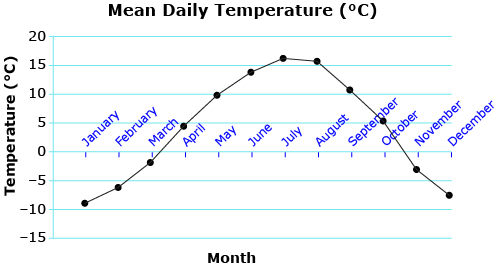You may have noticed that both y = sin θ and y = cos θ have a period of 2π, or 360°, and both have regular θ-intercepts that are  apart. This pattern continues infinitely for both positive and negative values of θ.
apart. This pattern continues infinitely for both positive and negative values of θ.
Self-Check 2
- Estimate the period and amplitude of the graph Mean Daily Temperature (°C).

Answer
-
Complete questions 10.a., 10.c., and 14 on pages 234 and 235 of the textbook. Answer
You have begun to see how the graphs of y = sin x and y = cos x are related. Now you will look at transforming these functions.
Try This 4
A family of functions similar to y = sin x can be represented by the equation y = a sin (bx), where a and b are constants. Use Sine a, b Explorer and Cosine a, b Explorer to investigate how changing these parameters will change the graph of y = sin x and to answer the questions that follow.

- Record your observations in a table like the one shown as you explore Sine a, b Explorer. Select the check boxes in Sine a, b Explorer to easily see amplitude, period, and the original y = sin x.
| |
Value of a or b |
Changes to Graph |
Sketch |
Amplitude |
Period |
| Increase a. |
|
|
|
|
|
| Decrease a. |
|
|
|
|
|
| Return a to 1. |
|
| Increase b. |
|
|
|
|
|
| Decrease b. |
|
|
|
|
|
- Now use Cosine a, b Explorer to investigate how changing the parameters a and b changes the graph of y = a cos(bx). Record your observations in a table like the one shown.
| |
Value of a or b |
Changes to Graph |
Sketch |
Amplitude |
Period |
| Increase a. |
|
|
|
|
|
| Decrease a. |
|
|
|
|
|
| Return a to 1. |
|
| Increase b. |
|
|
|
|
|
| Decrease b. |
|
|
|
|
|

- Find a numeric relationship between a and the amplitude.
- Use your rule to determine the amplitude if a = 27.
- Use your rule to determine a if the amplitude is
 .
.
- Find a numeric relationship between b and the period.

- Use your rule to determine the period if b = π.
- Use your rule to determine b if the period is 60.
 Save your tables and responses in your course folder.
Save your tables and responses in your course folder.
Share 3
With a partner or in a group, discuss the following questions:
- How do the rules that you determined in Try This 4 compare?
- How are these rules related to the transformations you learned in Module 1?
 If required, save a record of your discussion in your course folder.
If required, save a record of your discussion in your course folder.
![]() apart. This pattern continues infinitely for both positive and negative values of θ.
apart. This pattern continues infinitely for both positive and negative values of θ.

